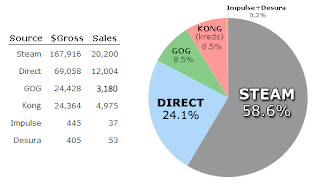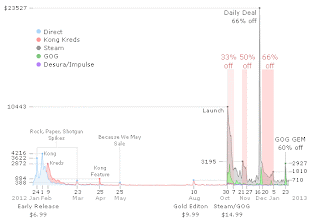Steam is Great for Gross (Revenue).
To the left is a breakdown of the gross revenues received from each distribution method. It is immediately obvious that getting your game available on Steam is an excellent objective to power sales - even though they did not sell their game on Steam for as long as other platforms (direct sales took place for several months before the other sales platforms made agreements with Level Up Labs), Steam had by far the biggest amount of revenue and most sales. Nevertheless, it is very important to notice how well selling direct worked for Level Up Labs, particularly taking into account the fact that direct sales generate the most revenue for Level Up Labs themselves - the company they used to process payments for direct sales took only 8% of the sale, and all other sales platforms took a larger chunk (which Level Up Labs was unable to share with us due to Non-Disclosure Agreements but is most likely around 30%, with Steam being the distributor most likely to take the biggest cut).
The most important things to take from this topic are that it is better to have a bigger variety of distributors, Steam is an extremely powerful revenue generator, and setting up direct sales is extremely important as it is still a significant cut of your overall revenue and it gives you a customer base with loyalty to the indie developer themselves, rather than to a platform first (like Steam).
Sales Sell
Lars Doucet of Level Up Labs also makes a very helpful graphic showing the relationship between discount sales and the number of sales that happen during the sale. From the graphic it is immediately clear and quite interesting that by far the most revenue was generated during the time where the game was discounted to the lowest per unit price. In other words, even though they temporarily lowered the actual price of the game to only five dollars per sale, they sold such a vastly higher quantity of units that they made by far more revenue than when the game was full price. Doucet does note later on that after reviewing the numbers of the sale they decided that they had most likely underpriced their game and they could have probably generated more overall revenue if they had kept the price a bit higher, but regardless these sales were clearly excellent overall for Level Up Labs - without any sale, they would have undoubtedly had much lower overall revenue.
If interested in the entire article, you may find it here. They cover some more topics which are less related to the distribution platform but are still interesting. For anyone looking into developing and selling an indie game, this article provides some great information on how and where you should focus on selling your game: attract Steam, continue to sell direct, and utilize sales to create interest and purchases.


No comments:
Post a Comment